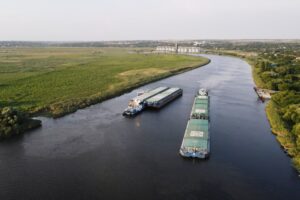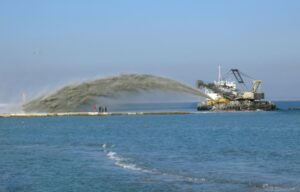
Participants in the panel discussion “The Strategic Role of the Danube in Logistics and Connectivity” at the international forum in Bucharest concluded that the Danube has become one of the key logistical and strategic corridors in the context of Russia’s war against Ukraine, the growth of hybrid threats, and the need to strengthen NATO and EU military mobility. In their opinion, improving the resilience and security of the Danube infrastructure should be considered a priority not only for coastal states but also for the entire Euro-Atlantic community.
The panel was moderated by Stefan Hofmann, head of the Konrad Adenauer Foundation’s offices in Romania. The discussion was joined by Andriy Kashuba, Deputy Minister of Community and Territorial Development of Ukraine (via videoconference), George Scutaru, Director General of the New Strategy Center, Wilfried Jilge, Associate Expert at the German Council on Foreign Relations, and Rear Admiral (ret.), Senior Associate Expert at the New Strategy Center, former commander of the Romanian Navy’s Maritime Component Liviu Coman.
The speakers emphasized that after the start of the war in 2022, traditional transport routes in the region became overloaded or vulnerable to military and hybrid attacks. This accelerated the development and more intensive use of the Danube infrastructure as an alternative corridor. Ukraine, they said, relies critically on Danube ports to maintain grain exports and support broader supply chains, while repeated Russian strikes on port infrastructure have exposed its vulnerability.
Participants emphasized that attacks on port facilities on the Danube have demonstrated the need for accelerated modernization of transport, transshipment, and surveillance systems, as well as enhanced protection of maritime and river infrastructure. This included expanding port capacity, upgrading the fleet, digitizing logistics processes, and improving coordination between military and civilian structures.
Following the discussion, the panel concluded that the Danube is a strategic hub for the entire Euro-Atlantic security architecture—a corridor for military mobility, a vector for economic integration, and a platform for regional cooperation. Participants emphasized the need for closer coordination between Romania, Ukraine, and the Republic of Moldova, including Ukraine’s full integration into European military mobility programs, strengthening port infrastructure, removing administrative barriers, and creating joint mechanisms to counter hybrid threats. According to experts, strengthening the stability and security of the Danube corridor is not just a regional task, but a strategic condition for the stability of Europe as a whole.

Ukraine has announced an international tender for the purchase of a modern multifunctional vessel for Danube ports, which will perform environmental, emergency rescue, and technical tasks.
According to a statement by the State Enterprise “Ukrainian Sea Ports Authority” (USPA), the vessel will be designed to operate in the ports of Izmail, Reni, and Ust-Dunaysk, which are currently key logistics hubs in the south of the country.
According to the technical specifications, the new vessel will be able to collect oil products and debris from the water surface, extinguish fires on ships and port facilities, and perform tugboat and mooring functions, assisting large ships in maneuvering.
The project is being implemented as part of the RELINC (Restoration of Essential Logistics Infrastructure and Network Connectivity) program with the support of the International Bank for Reconstruction and Development (IBRD).
Experts note that the new vessel will not only strengthen the port infrastructure, but will also be an important element of the environmental safety of the entire Danube.
Danube ports currently handle more than 40% of all Ukrainian agricultural exports and play a key role in international logistics, especially after the blockade of Black Sea routes.
The Danube is approximately 2,850 km long, the second longest river in Europe after the Volga.
The river basin flows through 10 countries — Germany, Austria, Slovakia, Hungary, Croatia, Serbia, Romania, Bulgaria, Moldova, and Ukraine — and flows into the Black Sea through the Danube Delta, part of which is located in the Odesa region.
According to estimates by the European Commission and the International Commission for the Protection of the Danube River (ICPDR), the level of pollution in the river remains moderate, but there is an accumulation of heavy metals, pesticides, and microplastics, especially in the tributaries.
The main sources of pollution are industrial discharges, agrochemicals, household waste, and shipping.

Ahead of the annual Danube Day, experts and environmentalists are drawing attention to the large-scale environmental threats facing Europe’s largest river system. Over the past 150 years, the Danube has lost about 80% of its natural floodplains and wetlands due to human intervention, dam construction, hydropower, active shipping, and river regulation. This has led to a sharp decline in biodiversity, the disappearance of sturgeon fish, and a weakening of the ecosystems’ ability to withstand floods and droughts.
The total length of the Danube is approximately 2,857 km. It is the most international river in Europe, flowing through or serving as the border of ten countries.
In Germany — about 214 km,
in Austria — 294 km,
in Slovakia — 166 km,
in Hungary — 334 km,
in Croatia — 129 km,
in Serbia — 269 km,
in Bulgaria — 148 km,
in Romania — 825 km,
in Moldova — 49 km,
in Ukraine — about 109 km.
Approximately 83 million people live in the river basin, more than 20 million of whom depend on the Danube as a source of drinking water. The capitals of four European countries are located along the Danube: Vienna, Bratislava, Budapest, and Belgrade.
Among the most serious problems are:
pollution with organic and toxic substances coming from sewage and agricultural land;
clogging with household waste, including plastic;
climate change and water level fluctuations;
invasive species;
construction of dams and hydroelectric power plants that interfere with fish migration;
poaching of sturgeon for black caviar.
Hydraulic structures such as the Iron Gate dam on the border between Serbia and Romania have completely blocked the path to spawning grounds for dozens of fish species.
The WWF Living Danube Partnership initiative has already restored more than 1,700 hectares of wetlands and improved water supply over an area of 3,700 hectares.
The LIFE-Boat 4 Sturgeon project is working to conserve sturgeon, create a genetic bank, and restore populations.
Rational water use systems are being developed, water purification filters are being introduced, and sustainable land use is being implemented.
Companies operating in the Danube basin are being held accountable for water resources.
The Danube remains a vital river for tens of millions of people and the last refuge for unique species of fish and birds. The conservation and restoration of the Danube requires international coordination, a systematic approach to nature conservation, and conscious policies on the part of the countries in the region. The river that Strauss wrote about in his famous waltz “On the Beautiful Blue Danube” must retain its natural character in the 21st century.

One of the largest grain market operators in Ukraine, Nibulon JV LLC, is entering new markets in the Middle and Upper Danube, expanding its operations in the region and offering a full cycle of grain and metal exports, as well as cargo transportation of all types of goods via the Danube, the grain trader’s press service reported on Facebook.
The agricultural holding reminded that the first steps in the Middle and Upper Danube markets were voyages with metal products on the routes Izmail – Lom (Bulgaria) and Izmail – Smederevo (Serbia), which were carried out by the tugs Pereyaslavsky and Kozatsky using barges of its own production. These shipments confirmed the company’s readiness to work efficiently with various categories of cargo, opening up new business opportunities in Bulgaria, Serbia, Romania and other countries in the Danube region.
“Our fleet is capable of transporting various types of cargo, and this is just the beginning. We offer comprehensive solutions to the Balkan business: grain exports combined with our logistics on the Danube to Constanta, as well as river transportation of any goods between the ports of the region,” said Sergey Kalkutin, Nibulon’s Logistics Director.
Nibulon assured that expansion to the Middle and Upper Danube is part of the agricultural holding’s long-term strategy aimed at developing international river logistics.
Currently, the agricultural holding is ready to offer a competitive alternative to traditional ways of supplying grain and other cargoes. This includes grain exports to 75 countries using its own river fleet, cargo transportation on the Danube for the agricultural, metallurgical and construction sectors, and flexible terms of cooperation: DAP, EXW, FCA, FOB, real-time online cargo tracking, international experience and reputation as a reliable partner.
“Thanks to its own modern fleet and efficient logistics, Nibulon guarantees stable and safe transportation on the Danube, which opens up access to new markets,” the agricultural holding emphasized.
Nibulon JV LLC was established in 1991. Prior to the Russian military invasion, the grain trader owned 27 transshipment terminals and crop reception complexes, facilities for simultaneous storage of 2.25 million tons of agricultural products, a fleet of 83 vessels (including 23 tugs), and the Mykolaiv Shipyard.
“Before the war, Nibulon cultivated 82 thousand hectares of land in 12 regions of Ukraine and exported agricultural products to more than 70 countries. In 2021, the grain trader exported the highest ever 5.64 million tons of agricultural products, reaching record volumes of supplies to foreign markets in August – 0.7 million tons, in the fourth quarter – 1.88 million tons, and in the second half of the year – 3.71 million tons.
Currently, the grain trader is operating at 32% of capacity, has set up a special unit to clear agricultural land of mines and had to move its headquarters from Mykolaiv to Kyiv.
BULGARIA, CARGO TRANSPORTATION, Danube, NIBULON, ROMANIA, SERBIA

Ukraine within the framework of the meeting Ukraine – USA – European Commission – Romania – Moldova in Romanian Galati identified among the priority areas of work to increase Ukrainian exports the realization of the potential of the Danube and checkpoints on the border with Romania, said Deputy Prime Minister – Minister of Development of Communities, Territories and Infrastructure of Ukraine Oleksandr Kubrakov.
“Today in Romanian Galati within the framework of the meeting Ukraine – USA – European Commission – Romania – Moldova worked on ways to increase Ukrainian exports. The Romanian part of the Danube in conditions of limited navigation is important for the reorientation of exports,” he wrote in Facebook.
According to him, the key areas of work are the acceleration of the passage of ships through the channels, increasing the capacity of the Sulina channel and the organization of additional places for the raid transshipment of ships near the Romanian port of Constanta.
Deputy Prime Minister noted that for the realization of these plans investments are needed. To attract them, work with European partners is underway, in particular, on the inclusion of the Ukrainian part of the Danube in the maps of the Trans-European Network of Inland Navigation Routes (TEN-T).
“This is one of the important conditions for the full-fledged operation of business on the Ukrainian Danube transportation market,” he stressed.
Kubrakov added that work is also underway with the Romanian side on the full-fledged launch of freight transportation at the road checkpoints on the border with Romania “Krasnoyilsk – Vicovu de Sus” and “Diakivtsi – Rakovets”. There are plans to increase the capacity of “Porubnoye – Siret” by at least 20% and to open two more new checkpoints, the report said.
In the railway transportation direction, active work is being carried out both in the Romanian and Moldovan directions, the deputy prime minister said. He recalled the resumption of the passenger trains’ movement on the border with Romania on the Rakhiv-Delovoye-Valia-Visheului section, as well as the works on the resumption of the passenger traffic at the Teresva border crossing point.
As it was reported at the meeting of the Exporters’ Office at UZ, a number of measures are also planned to increase the volume of cargo transshipment in the direction of the port “Izmail”. In particular, the reconstruction of dead-end tracks No. 8 and No. 9 at the station “Izmail” is planned by the end of the year. It is envisaged that UZ will perform the works at the expense of the investor. In 2024 it is planned to build an additional extraction track parallel to the existing No. 13 in the park “Izmail-Portovyi”. In addition, it is planned to build two marshalling tracks between tracks #11 and #15. There are plans to electrify the Artsiz-Izmail line with a length of 202 km.
“All our actions are aimed at achieving one goal – to provide as many opportunities as possible for Ukrainian exporters,” Kubrakov emphasized.
Deputy Prime Minister expressed gratitude to US sanctions coordinator Jim O’Brien, US Ambassador to Ukraine Brigitte Brink, European Commission Director General for Transport Magda Kopczynska, Romanian Minister of Transport and Infrastructure Sorin Grindian and Moldovan Minister of Agro-politics Vladimir Balea for their support.
He also recalled that recent Russian attacks on Ukraine’s port infrastructure destroyed more than 200,000 tons of grain.

Ukraine has completed dredging of the mouth of the Bystroe River Danube, bringing the draught of vessels at the section from the 0th kilometer of the mouth of the Bystroe River to the 77th kilometer of the Kiliya mouth to 6.5 meters, the Ministry of Restoration said on Friday.
According to its release, the section from the 77th kilometer to the 116th kilometer of the Kili estuary has a passing draft of 7 meters, whereas at the beginning of the full-scale intrusion, the maximum draft was only 3.9 meters.
“This is the first time we have been able to increase the allowable draught of vessels under independent Ukraine. Thanks to this we will be able to provide more efficient and safe navigation between the Black Sea and the Danube River, as well as increase the cargo flow through the Danube ports,” the report quotes Deputy Prime Minister – Head of the Ministry of Reconstruction Alexander Kubrakov as saying.
He added that since March 2022, transshipment of cargo in the ports of Izmail, Reni and Ust-Dunaisk has increased by three times. In general, more than 17 million tons of products, including more than 11 million tons of food products were exported from them.
According to the department, an increase in the draft for the passage of ships through the mouth of the “Bystroe” to the specified level became possible thanks to the elimination of the consequences of drift, the removal of sediment from the soil, the elimination of rollovers and the restoration of passport characteristics within the water areas of sea ports of Ukraine.
As reported, the passage of ships through the mouth of the “Bystroe” was opened on July 9, 2022 after the liberation of the Snake Island from the occupants.